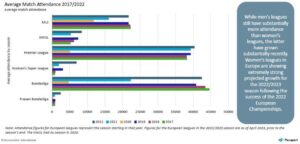- Over 2 billion to tune into FIFA Women’s World Cup 2023, up from 1.12 billion in 2019
- Women’s club football stadium attendance for 2022 in top leagues already exceeding pre-Covid levels
- FIFA Women’s Football World Cup kicks off as audience for club football is on a high across Germany, England, and the US
- English Women’s Super Leagueregistered whopping 729% attendance growth between 2017 and 2022
LONDON, UK: Television viewership and stadium attendance figures will smash records at FIFA Women’s World Cup 2023, market research company Euromonitor International is forecasting.
The FIFA Women’s Football World Cup 2023 is kicking off at the right time as audiences for women’s football leagues are showing rapid growth worldwide, statistics from Euromonitor show.
Euromonitor International also looked at attendance and viewership figures from past FIFA Women’s World Cups as well as three major club football leagues – Germany’s Frauen Bundesliga, England’s Women’s Super League (WSL) and the USA’s National Women’s Soccer League (NWSL).
The research showed that stadium attendance and television viewership across all the aforementioned competitions had registered big increases, with numbers already surpassing pre-Covid highs from 2019 at the club level.
FIFA Women’s World Cup 2023 viewership set to nearly double from last edition
The 2023 FIFA Women’s World Cup is expected to set viewership records for the women’s game, hoping to attract over 2 billion viewers.
1.12 billion viewers tuned into official broadcast coverage of the Women’s World Cup in 2019, with the average live match attracting 17.27 million viewers, more than double the average of 8.39 million viewers in 2015. The final reached over 263 million unique viewers.
Viewership of the English Women’s Super League continues to grow, increasing 70% in the 2022-2023 season according to broadcast partner Sky, with viewership totaling 21.1 million from January to May 2022, according to the Women’s Sports Trust. While this is much smaller in comparison to the 3.2 billion that watch Premier League matches annually, it shows significant growth in the number of fans tuning into women’s sports.
English league average attendance up massive 729% since 2017, Germany up 190%
While the men’s leagues have more attendance than the women’s leagues, the women’s leagues have continued to register rapid year-on-year growth as well as room for projected future growth.

Attendance for women’s club football leagues has grown substantially over the past five years across the top leagues. The English WSL led the pack with average attendance growing 729% from 839 in 2017 to 6,961 in 2022.
Average attendance in Germany’s Frauen Bundesliga has grown by 190% in the past five years. Frauen Bundesliga’s average match attendance stood at 2,461 in 2022, which is up from 848 in 2017.
The USA’s NWSL attendance continued to go from strength to strength as well, with an average attendance of 8,421 in 2022, growing from the 2017 average of 5,254.
Reflecting on the findings, Dorothy Calba, Senior Analyst at Euromonitor International, said:
“Attendance during the club season of 2022-23 was spurred forward by a very highly attended and viewed 2022 UEFA European Women’s Championship. This helped grow attendance in European markets, but also grew international interest in the game. While this growth is promising, there is still a lot of room for expansion to reach the average attendance levels on the men’s side and consistent investment from sponsors can help drive this growth. The Women’s World Cup 2023 is also likely to aid this growth as fans flock to stadiums next season to watch the stars of the tournament.”
Club and international football records are being shattered in the women’s game
Brands are seeing an opportunity in the expanding attendance and viewership of women’s football matches. While women’s matches still draw less attendance on average than the men’s leagues, the attendance and viewership of women’s games have grown substantially in recent years.
In 2022 alone, multiple women’s attendance records were set both on the international and the club football stage, including 92,000 fans that watched Barcelona take on Wolfsburg in the UEFA Women’s Champions League semi-finals, and 87,000 fans that watched England and Germany face off in the Women’s UEFA European Championship final.
The last three World Cups have seen the highest attended women’s game reach above 70% of the attendance at the highest attended men’s games.
Digital engagement strong in women’s football
The men’s league has more TikTok followers on average, but the average engagement rate per follow of the women’s league was more than double that of the MLS in 2022.

Many women’s sports fans were for a long time unable to access coverage of their teams on traditional broadcast channels and thus have migrated a lot of their fandom online. Fans want to engage directly with their teams and top players online, both through match coverage and through personalised coverage of the players’ lives both on and off the pitch.
This level of engagement can be seen in Euromonitor International’s social media data as it corresponds to the top women’s and men’s football leagues in the US.
Calba added: “The engagement rate of women’s fans with their team online shows the strong desirewomen’s football fans have for content involving their favorite teams and players. This connection between fan and team provides a key opportunity for brands to reach a new and unique consumer base.”
You can learn more about the state of women’s football today in Euromonitor International’s report, Sponsorship in Women’s Football.
ABOUT EUROMONITOR INTERNATIONAL
Euromonitor International is the world’s leading provider of global business intelligence, market analysis and consumer insights. From local to global and tactical to strategic, our research solutions support decisions on how, where and when to grow your business. With offices around the world, analysts in over 100 countries, the latest data science techniques and market research on every key trend and driver, we help you make sense of global markets.
Image by Milton Galvan from Pixabay











